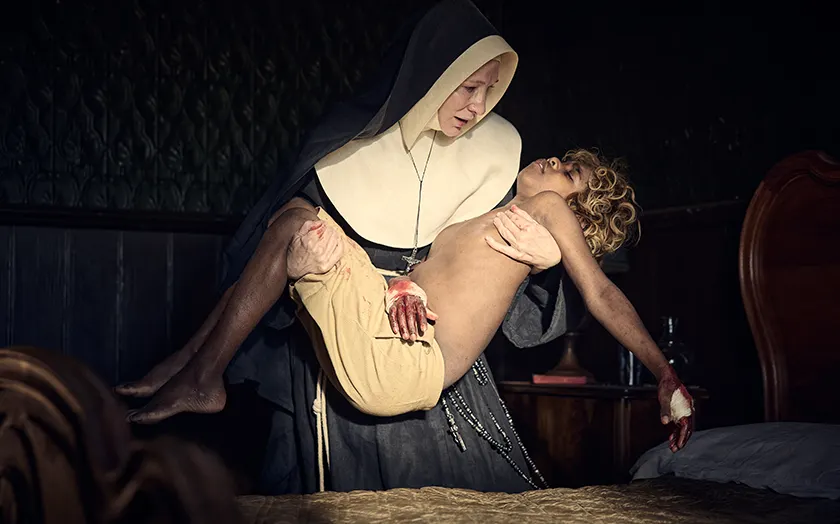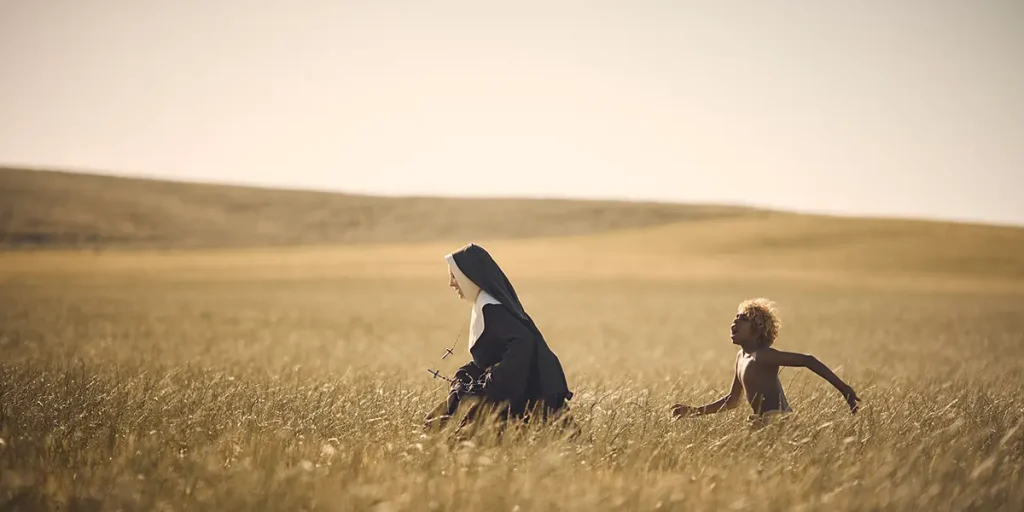Warwick Thornton’s The New Boy is a thematically interesting and superbly acted fable that might be a bit too obtuse for some.
Writer and Director: Warwick Thornton
Genre: Drama
Run Time: 116′
U.S. Release: May 23, 2025 in select theaters; May 30, 2025 on demand
U.K. & Ireland Release: March 15, 2024 – Out now on digital & VOD
Warwick Thornton’s The New Boy is not a movie interested in telling a conventional narrative, but in building tone and developing themes through potent imagery and interesting characterisation. Very lightly based on Thornton’s own experiences as an aboriginal child, The New Boy ends up being all about a battle of faiths; about how divinity can be found in different cultures and different ways, and about how trying to transform one form of divinity into another can simply destroy it.
Cate Blanchett stars as Sister Eileen, who runs a monastery in the middle of the Australian outback in the 1940s. As the film starts, the titular boy is caught by the police in the desert and sent to Eileen’s orphanage full of aboriginal little kids, all sporting biblical names. As a title card in the beginning tells the audience, though, these children aren’t living with Eileen and another nun, Sister Mum (Deborah Mailman), because they lack families. Unfortunately, the church is helping the government with a program of ethnic cleansing, consisting of the separation of Aboriginal kids from their families, which is supposed to help “clean” the Australian population.
That’s not the only secret the nuns keep, though. The monastery is supposed to be managed by a cleric named Dom Peter, but since his disappearance, Eileen has been in charge of everything, a fact she must hide from both Church authorities and any other people who might come her way. And with the New Kid’s arrival, she must handle that, and the fact that the child starts showing signs of divinity. He is able to generate a little ball of light with his fingers; he apparently has healing powers; he suffers from stigmata, and he even gets winks and blinks from a newly-arrived statue of Jesus Christ. As the nuns – and a local named George (Wayne Blair) – discover the true nature of the kid, they begin struggling with the fact that a non-Christian might be more divine and pure than any of them.

Thematically speaking, The New Boy has a lot to say. Combining a realistic setting and references to historical events – the movie takes place during the waning days of World War II, for example – with a more fantastical tone, the film ends up feeling like a sort of fairy tale, more interested in the symbolic power of its ideas than in developing a traditional three-act story. Thus, The New Boy manages to convey themes like the violent nature of colonisation, the aggressiveness of religious transformation, and the possibility of finding the divine outside a Christian population in a suitably intriguing setting.
In that sense, the film’s true protagonist is not Sister Eileen, but the titular New Boy. Newcomer Aswan Reid gives a truly marvellous performance, barely saying a word throughout the nearly two-hour runtime, managing to convey a lot purely through body language and facial expressions. He portrays the kid as a mysterious figure, more symbolic than truly human; as a potentially divine creature with powers beyond comprehension, who is nevertheless underestimated by the adults and treated as the “Other” because of his “status” as an Aboriginal.
This takes me to one of New Boy’s most compelling messages: that Aboriginals have always been treated differently, and in the times the movie’s set in, almost like animals. Consider, for example, George’s first interaction with the boy, in which he calls him as if he were a dog, getting him to try a bit of marmalade. The New Boy makes it clear that no matter how special, perceptive and intelligent the kid might be, he will always be treated not like a normal human being, but again, as the “Other”. The colonisers’ faith simply cannot come to terms with the fact that someone different might be more divine than them, despite all the evidence in front of their eyes.
All this is exemplified by Sister Eileen, who is not necessarily a bad person, but who is still complicit in the Church’s (and the government’s) terrible actions against the Aboriginal population. She does try to help the kids in the monastery, and she even lies about Dom Peter’s disappearance, all in order to keep the kids under her supervision. But at the same time, she feels incredibly guilty about all the sins she’s committing, and eventually decides not to respect the New Boy’s nature, but to bring him to her faith, transforming him into something he’s not, thus relieving him of his powers.
The New Boy, then, is all about the contrast of faiths and the way certain people of faith simply cannot understand other cultures and other perspectives and the possibility that maybe, just maybe, they’re not the only ones close to God. Cate Blanchett is excellent as always, portraying Eileen as a nun who starts doubting her own faith and even her own reality, and the film as a whole looks amazing, giving us plenty to look at in the Australian outback.
The New Boy’s dreamy tone will not be for everyone, and the fact that it’s more interested in “vibes” and symbolism than in story can be frustrating, but the experience as a whole is rewarding enough, so long as the viewer is paying attention.
The New Boy: Movie Plot & Recap
Synopsis:
A nine-year-old Aboriginal boy is found in the middle of the outback and taken to live in a monastery run by two nuns and populated by other (supposedly orphaned) children.
Pros:
- Thematically strong.
- Visually potent.
- Some interesting symbolism.
- Newcomer Aswan Reid gives a great central performance.
Cons:
- A bit too obtuse.
- Too dreamy for some audiences.
The New Boy will be released in select US theatres on May 23, 2025 and on demand on May 30. The film is now available to watch on digital and on demand in the UK & Ireland and more countries.
Loud and Clear Reviews has an affiliate partnership with Apple, so we receive a share of the revenue from your purchase or streaming of the films when you click on some of the links on this page. This won’t affect how much you pay for them and helps us keep the site free for everyone.

